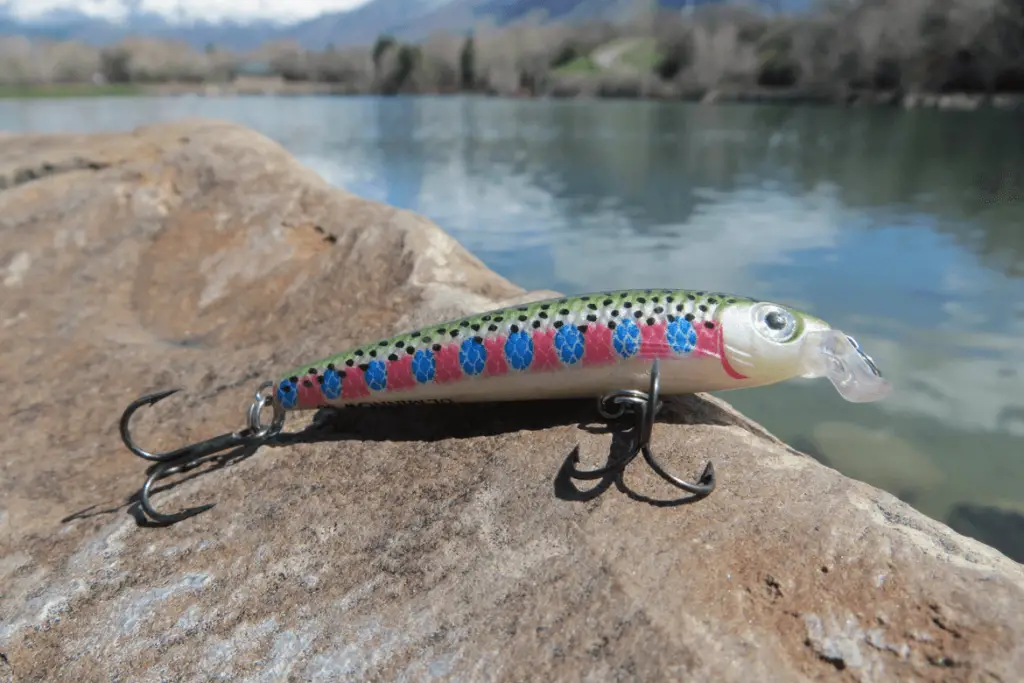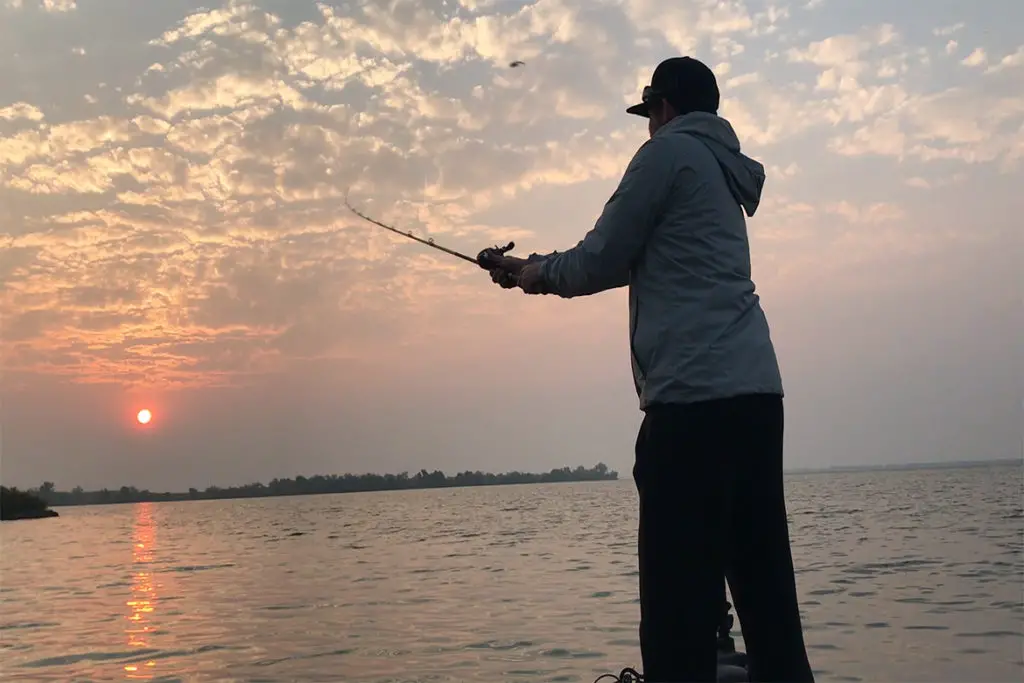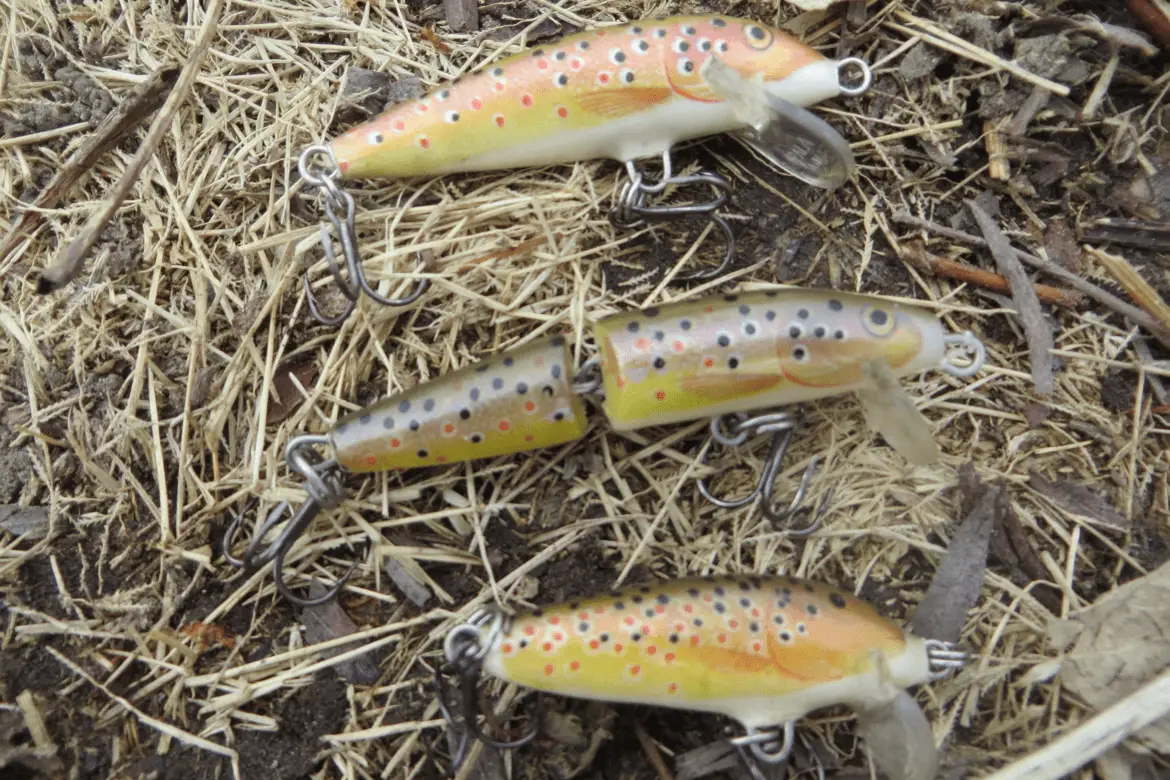Crankbaits are a popular lure made from a variety of material used to imitate crayfish, baitfish, and other prey. Crankbaits are an effective way to cover water, imitate natural forage, excel at triggering strikes and catching fish. Trout anglers that aren’t familiar with crankbaits often ask whether or not they can be used effectively to catch trout.
In my experience, using crankbaits can be an excellent way to catch trout and are often overlooked by many trout fishermen. In fact, I’ve caught some of my largest trout using crankbaits. You can use crankbaits to catch trout in rivers, small streams, ponds and big lakes and reservoirs.
Over the past few decades, I’ve spent a ton of time on the water throwing different crankbaits and catching trout successfully. Through this experience, I’ve learned a lot about what crankbaits work, what colors to use and when crankbaits are the most effective.
In this article, I plan on sharing with you everything that I’ve learned about fishing crankbaits for trout. After reading this, you’ll know exactly how to fish and use crankbaits to catch trout on your local waters.
Let’s get started.
Using Crankbaits to Catch Trout

Bass fishermen are commonly known for their use of crankbaits. Crankbaits can be extremely effective, and not only just for bass, but are great lures to use to catch trout and other species.
It’s widely known that trout eat a lot of insects, but many fishermen don’t realize how much trout also love to feed on minnows. This is especially true for lager trout. Much like streamers, crankbaits are designed to imitate minnows and they are extremely effective fish catchers.
Crankbaits vary in design with some having bills, unique sounds and different swimming actions. Much like tools in your toolbox, each type of crankbait is designed to be used in different fishing situations and conditions.
Here are the most common types of crankbaits.
Types of Crankbaits
Microcrankbaits
Microcrankbaits are just super downsized crankbaits with a small profile and tiny lip. They are popular to use for small trout, crappie, bluegill and other panfish. They can be difficult to cast far, but can work really well for smaller sized fish.
Squarebill Crankbaits
These crankbaits excel in shallow water and are designed to deflect off rock, wood, and other structure. These crankbaits are really popular among bass fishermen but can also work for other species as well.
Lipless Crankbaits
The name really gives it a way, but a lipless crankbait is a crankbait that doesn’t have a bill. These have a tight swimming action and tend to be the most productive early in the spring and fall. You can cast these a mile long and they sink fast. They are best used for larger rivers, lakes, and reservoirs.
Deep Diving crankbaits
Crankbaits with large bills that are designed to reach deep water. These are popular crankbaits to use for bass and other predatory fish species. Deep diving crankbaits are also effective to use when trolling.
Jerkbaits
Jerkbaits are a type of crankbait that excels at being ripped and jerked through the water using the tip of your rod. They produce a unique slashing action that imitates a dying baitfish. This action makes it hard for any nearby fish to resist.
Best Trout Crankbaits
If you are a bass fisherman you know how effective and fun fishing a crankbait can be. For some reason, crankbaits often get overlooked when it comes to spin casting for trout.
I’ve spent hundreds of hours on the water using crankbaits to catch a variety of trout species. I’ve used them to catch rainbows, brookies, cutthroats and browns. Crankbaits can be extremely effective for trout and will often produce some very large fish.
Here is a list of what I would consider to be the best crankbaits to use to catch trout and when and what situations they excel in.
1. Original Rapala (Floating)

It’s hard to find a better crankbait to use to catch trout than the world renowned original Rapala. This is one of my go-to lures. It works great on top as a surface bait or retrieved as a shallow runner. I have caught more trout on this crankbait than any other lure. It’s my tried and true.
The action of this bait replicates a wounded minnow that makes it hard for trout to resist. This is a lure that should be on the top shelf of everyone’s tackle box.
This small crankbait works excellent in rivers, streams and small ponds and lakes. If I can only choose one crankbait to use, catching trout with the Original Rapala would be my number one choice.
2. Dynamic HD Trout

The Dynamic HD Trout is a fantastic crankbait that has an excellent combination of casting distance, unique swimming action, and a realistic profile.
This small crankbait excels in high current situations like in rivers, streams and creeks, and also works well in lakes, reservoirs, and ponds where there isn’t any current.
I really like the components, hardware, and build of this crankbait. It comes in a variety of unique and realistic color patterns making it easy to match the hatch and body of water you are fishing.
If you are looking to add a crankbait to your tackle box, I’d highly recommend picking up one of these Dynamic HD Trout lures. Not many anglers are using them, and they are highly productive.
3. Trout Magnet Crank

Another fantastic trout crankbait that I’ve found to be really effective is the Trout Magnet Crank. This small crankbait was originally designed for trout, but also works great for all species. It has a small bill in the front allowing the lure to run about 2-4 feet deep.
I have found this crankbait to excel in small creeks, rivers and ponds and catch anything from stocked trout to large browns. It has a slender design making it easy to rip it and creates a perfect stop and go action. The crankbait also rattles when on the move, increasing its effectiveness.
Overall the Trout Magnet Crank is an excellent crankbait to catch trout with. I’d highly recommend adding it to your tackle box collection.
4. Rapala Rippin’ Rap

A lipless crankbait can be a deadly way to catch trout as well as other species. I’ve used a variety of lipless crankbaits over the years, but the Rapala Rippin’ Rap seems to outperform and catch trout more consistently.
Lipless crankbaits sink fast and are easier to cast compared to the other types of crankbaits. They also have a much tighter swimming action and work really well in cold water situations. They also come with loud rattles calling in fish from long distances. Due to their extra weight they are best utilized in deeper water or when trolling.
I’ve found the best lure retrieval is either using a straight retrieve or using a rip ‘n’ dip action. However, there really isn’t a wrong way to fish with it.
If you primarily fish large bodies of water or deeper rivers, I’d highly recommend trying out a lipless crankbait. They will be an excellent addition to your tackle box.
5. Megabass Vision 110

When I first started using the Megabass Vision 110 I used it to primarily target largemouth and smallmouth bass. What I learned while using it was it is also a deadly crankbait for trout. Don’t let the name of this crankbait fool you, this thing is a trout catching machine.
This is a premium crankbait that many anglers refer to as a jerkbait or a rip-bait. It has a unique one-of-a-kind darting action, comes in super realistic color patterns and is a fish catching machine. It comes in a few different sizes and running depths that make it easier to choose one that best matches your body of water.
In my experience the Vision 110 shines when fishing points, flats, rack banks, bluffs, above submerged grass, around boat docks, and other times of structure. The only downside to this crankbait is that it is much more expensive than the others mentioned on this list. However, the effectiveness and overall quality of this crankbait is well worth the extra cost.
Best Crankbait Fishing Setup
Just like any fishing technique, having the right line, tackle and setup for the technique you are using is extremely important. This is especially true when fishing with crankbaits.
Here is what I have found to be the best equipment and setup to use.
Rod & Reel
For most trout anglers wanting to throw a crankbait, I’d recommend using a rod between 6’6” and 7ft long, that has a medium or medium light power with a fast action.
This size of rod is a perfect general-purpose length that will help you effectively catch trout with crankbaits from the bank or from a boat. I’d recommend pairing this rod length with a medium or medium light powered rod with a fast action.
If you primarily fish big lakes where casting distance is more important I’d get a longer rod like a 7ft medium powered with a fast action. If you are fishing small streams a shorter rod would be ideal. Some anglers will use a rod as short as 5ft in these situations.
As for the reel, I’d recommend using a spinning reel that is between a 1000 to 2500 size. The smoother the reel and lighter you can find the better.
Line
The type and size of your fishing line can change the action and depth your crankbait will run. The less diameter a line has the more depth you will get from your crankbaits.
In my experience the best line to use when fishing a crankbait for trout is 4-8lb test fluorocarbon. Fluorocarbon sinks are extremely sensitive and work really well with crankbaits.
No Swivel
A lot of anglers use a swivel when using inline spinners and crankbaits. Although these make switching out lures really easy, it also impacts the action of your crankbait in a negative way. There are some lures where it won’t make a huge difference, but I would recommend tying directly to your main fishing line without using a swivel.
Best Crankbait Colors for Trout
When shopping at your local tackle shop as you get ready for your next fishing trip, you’ll see there are hundreds of different crankbait colors and color options to choose from. With so many choices it can seem overwhelming training to select the right crankbait color.
I’ve spent hundreds of hours on the water testing different crankbaits and colors over the years. Through this experience, I’ve dialed in what colors and patterns work and ones that aren’t as productive.
In my experience, the best crankbait colors to use for trout are patterns with white, brown, gold, silver, blue and chrome. As well as any pattern or color that best matches the trout’s forage in your body of water.
When selecting a crankbait color or any trout lure color, it’s important that you match your colors with natural trout forage as well as the clarity of the water you’ll be fishing in.
In clear water situations I’ve found natural looking bait fish crankbaits to work best. In stained and muddy water, I like using dark or bright colors.
For more information on selecting the right lure color for trout check out this article: Best Colors for Trout Lures.
What Size Crankbait to Use
There are a ton of different crankbaits out there you can choose from. With so many choices I often get asked what size of crankbait is best to use for trout.
In my experience, the best overall size of crankbait to use when fishing for trout is a crankbait that is between 1.5 and 2.5 inches long. This size seems to be the most versatile and will help you catch more fish.
With that being said, there are two things I like to consider when trying to decide which crankbait size to use: size of trout I’m targeting and the size of the minnows I’m trying to imitate.
If I know there are larger trout where I’m fishing or I’m specifically targeting a trophy I’ll use a much larger crankbait (2.5” to sometimes 8” long). On the other hand, if I’m fishing a small creek or pond where the fish tend to be small I might down size.
How to Fish a Crankbait

Using crankbaits for trout is an incredibly successful way to catch fish. One of the main benefits of using crankbaits is that it allows you to cover water efficiently and target specific depth ranges. They also excel at drawing in and triggering inactive fish nearby.
Here are some tips on how to effectively fish crankbaits for trout.
Crankbait Fishing Tips
Make long casts
Perhaps one of the most important aspects of fishing a crankbait is making a long cast. It’s pretty simple, the longer you can cast the more fish you will catch. Longer casts allow your crankbait to reach and stay in the strike zone for a longer period of time. They also increase your chances of not spooking any nearby fish.
Retrieval is Key
Using a straight retrieval can work just fine and will catch you fish, but I’ve found mixing up your speed up and adding some jerks or twitches can help tremendously. These subtle changes do an excellent job at triggering strikes and getting the fish to react.
Deflections Help
Another great tip is to deflect your crankbait off of wood, docks, rocks and any other type of structure. This quick change in direction will make your crankbait irresistible to any nearby fish. In fact, I tend to get the most strikes when
Hook Sets
When you do feel a strike, setting the hook in most cases isn’t necessary. All you need to do is keep reeling and make sure your line stays tight. When trout do hit a crankbait, they will hit it hard and will self-hook and the treble hooks will help keep them pinned.
Landing Fish
Like any other lure, when you do have a fish on with a crankbait it’s really important to keep your line tight. Any slack in your line can result in a lost fish. Keep a taut line and don’t rush landing it, but also don’t over play them. If you do this you’ll have a lot more success landing your catches.
Other Popular Trout Lures
Crankbaits are one of my favorite lures to use to catch trout. They do a great job at imitating baitfish and are a lot of fun to use and catch fish with. However, there are also other productive trout lures anglers can utilize as well.
Here is a list of some of the other popular and productive trout lures.
Inline spinners
Inline spinners also work extremely well for catching trout. The highlight of this lure is the spinning blade on the lure’s shaft that triggers strikes from nearby fish. The flash and vibration of the inline spinner is what makes it a great lure to use.
Spoons
Much like crankbaits, spoons typically imitate swimming and injured baitfish and are a super productive way to catch fish. They are typically made of some type of metal and vary in color and design. Spoons work really well in most bodies of water and are a great addition to any tackle box.
Tube Jigs
Tube jigs are another lure not used enough to catch trout. When they fall they have a downward death spiral action that drives trout wild. A tube jig is a soft plastic tube paired with a small jig head. They are really easy to fish and work really well in lakes, rivers, ponds and anywhere trout can be found.
Final Thoughts
Many anglers targeting trout often overlook the effectiveness of using a crankbait. In my experience using crankbaits can be a fun and effective way to catch trout in small streams, rivers, ponds and lakes. If you haven’t already, I’d highly recommend picking up a few of the crankbaits mentioned in this article

